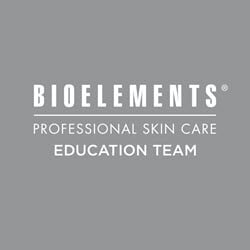
What makes the difference between a good facial and a great facial? How do you get clients to rebook? One of the reasons I love my role as Bioelements Director of Education is that I’m able to talk with skin care professionals every day about what happens in the treatment room – the good and the bad. I’ve spoken with thousands of estheticians, and over my almost two decades in the industry, I’ve noticed that the same three easily avoidable mistakes can derail any facial.
Mistake #1: Stimulating without sedating.
A client receives a facial at her neighborhood spa. When it’s over, she tells her esthetician her skin feels like it’s tingling and uncomfortable. What happened?
In this case, the client told the esthetician she had sensitive skin. In the treatment room, after exfoliating with a physical scrub, the esthetician used a microdermabrasion machine for additional physical exfoliation. After this “double exfoliation” process, she used nothing to calm or sedate the skin post-treatment.
The Fix:
Here’s the rule: if you stimulate, you must sedate. Any time you exfoliate, you must immediately follow with a skin sedation mask to prevent negative reactions. It’s a crucial step to instantly take down any redness, calm skin’s nerve endings and any cellular irritation. In this case – it was absolutely necessary, since this esthetician incorrectly performed a double exfoliation on a first time client with sensitive skin (another mistake that should have been avoided).
At any point in your treatment, if you see excess redness, or if the skin feels hot, or if at any point the client complains of itchiness, discomfort or burning, that’s your clue that the skin needs sedation. Be prepared to create an emergency soothing mask with ingredients like soothing colloidal oatmeal and hydrocortisone.
Mistake #2: Not knowing contraindications
Do you know all the different generic prescription names for Retin-A? An esthetician named Erica had a client tell her she was not on Retin-A, but when Erica waxed her, the skin lifted right off. It was only then that the client said she was on Atralin. Erica politely explained that Retin-A has many names, in order to prevent this from happening again.
Here’s another situation: esthetician Kate asked her long-time client if anything had changed since the last visit, and the client said no. So the facial proceeded. But during exfoliation Kate saw that the skin was lifting. She immediately sprayed the skin with cool water and applied a cool towel as she began to determine what was happening. She asked the client if there may have been something she forgot to share during the assessment. The client answered “yes” – she was now taking an antidepressant but was too embarrassed to tell her earlier. Kate looked up the drug and sure enough a side effect was thinning of the skin. She got through the treatment with a soothing, custom blended mask and she’s still Kate’s client today.
The Fix:
According to the Department of Health and Human Services, almost half of all Americans take at least one prescription drug. There are a lot of prescriptions your client can be on, so it’s more important than ever to be your own investigator. A SkinReading® is so vital. Pre-read the skin under your lamp, and look for clues – is her skin severely dehydrated, flaking, irritated or thin? It’s important to explain to your clients WHY you are asking the questions you ask – it’s their skin that’s at stake!
Pro Tip: Know your contraindications. For example, keep a list with you of the various names Retin A can be listed under. Post it on the wall or keep it easily accessible in the treatment room.
Mistake #3: Skipping the at-home recommendation
What would you do if, two weeks after receiving a facial, a client returns to you saying that the facial caused her to breakout? This happened to an esthetician who called me asking for advice.
The first thing I did after hearing this story was to ask the following: Did she perform a SkinReading® and professionally recommend the right products for her client to use at home? Her response… “No.”
The Solution:
Your service doesn’t end when the treatment finishes. In fact, you totally lose control of your treatment results once the client leaves your room if you don’t send her home with the right at-home products. You run the risk of the client assuming the facial is the cause of any future skin problems, which the client did in the example above.
When you professionally recommend the appropriate at-home agenda of products, you’re completing the ‘Circle of Treatment’ customers expect. At-home products are your insurance to maximize your facial results, make them last, and ensure client satisfaction.
Photography: Courtesy of Bioelements





